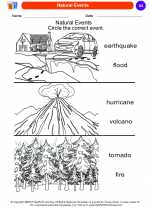Mountains
Mountains are large landforms that rise prominently above their surroundings. They are typically formed through the movement of tectonic plates, volcanic activity, or erosion and weathering over a long period of time. Mountains can be found on every continent and vary in size, shape, and formation.
Formation of Mountains
Mountains are formed through various geological processes:
- Tectonic Activity: Mountains can be formed when tectonic plates collide, causing the Earth's crust to fold and push upwards. This process creates fold mountains such as the Himalayas.
- Volcanic Activity: Volcanic mountains are formed when molten rock (magma) erupts from the Earth's mantle and solidifies to form a mountain. Examples of volcanic mountains include Mount Fuji in Japan and Mount Kilimanjaro in Tanzania.
- Erosion and Weathering: Mountains can also be formed through the gradual wearing down of the Earth's surface by processes such as wind, water, and ice. This can create mountain ranges and peaks over millions of years.
Types of Mountains
There are several different types of mountains:
- Fold Mountains: These are formed through the folding of the Earth's crust as a result of tectonic plate movement. Examples include the Rocky Mountains in North America and the Andes in South America.
- Volcanic Mountains: These are formed from the accumulation of hardened lava, ash, and other volcanic materials. Examples include Mount St. Helens in the United States and Mount Vesuvius in Italy.
- Block Mountains: These are created when large areas of the Earth's crust are uplifted, forming steep, rugged mountains. The Sierra Nevada in California is an example of block mountains.
Importance of Mountains
Mountains play a crucial role in shaping the Earth's landscape and have significant impacts on the environment and human activities. They provide habitat for a diverse range of plant and animal species, as well as valuable resources such as water, timber, and minerals. Mountains also attract tourists and outdoor enthusiasts, contributing to local economies and providing recreational opportunities.
Study Guide
Here are some key points to remember about mountains:
- What are the three main processes involved in the formation of mountains?
- List and describe three different types of mountains.
- Explain the importance of mountains in terms of their impact on the environment and human activities.
- Identify at least two famous mountain ranges or peaks around the world and describe their significance.
Understanding the formation, types, and importance of mountains is essential for gaining a comprehensive knowledge of Earth’s geography and natural landscapes.
[Mountains] Related Worksheets and Study Guides:
.◂Science Worksheets and Study Guides Kindergarten. Weather

 Coloring Worksheet
Coloring Worksheet
 Coloring Worksheet
Coloring Worksheet
 Coloring Worksheet
Coloring Worksheet
 Coloring Worksheet
Coloring Worksheet
 Coloring Worksheet
Coloring Worksheet
 Coloring Worksheet
Coloring Worksheet
 Coloring Worksheet
Coloring Worksheet
 Coloring Worksheet
Coloring Worksheet
 Coloring Worksheet
Coloring Worksheet
 Coloring Worksheet
Coloring Worksheet
 Coloring Worksheet
Coloring Worksheet
 Coloring Worksheet
Coloring Worksheet
 Coloring Worksheet
Coloring Worksheet
 Coloring Worksheet
Coloring Worksheet
 Coloring Worksheet
Coloring Worksheet
 Coloring Worksheet
Coloring Worksheet
 Coloring Worksheet
Coloring Worksheet
 Coloring Worksheet
Coloring Worksheet
 Coloring Worksheet
Coloring Worksheet
